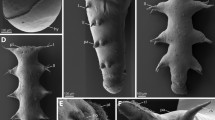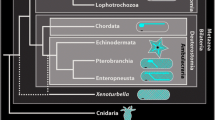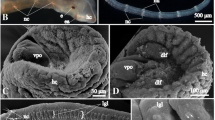Abstract
The Neritimorpha is an ancient clade of gastropods that may have acquired larval planktotrophy independently of the evolution of this developmental mode in other gastropods (caenogastropods and heterobranchs). Neritimorphs are therefore centrally important to questions about larval evolution within the Gastropoda, but there is very little information about developmental morphology through metamorphosis for this group. We used immunolabeling (antibodies binding to acetylated α-tubulin and serotonin) and serial ultrathin sections for transmission electron microscopy to characterize the apical sensory organ in planktotrophic larvae of a marine neritimorph. The apical sensory organ of gastropod larvae is a highly conserved multicellular sensory structure that includes an apical ganglion and often an associated ciliary structure. Surprisingly, the apical ganglion of Nerita melanotragus (Smith, 1884) does not have typical ampullary neurons, a type of sensory neuron consisting of a cilia filled inpocketing that has been described in all other major gastropod groups. N. melanotragus has cilia-filled pockets embedded within the apical ganglion, but these so-called “sensory cups” are cassettes of multiple cells: one supporting cell and up to three multiciliated sensory cells. We suggest that an internalized pocket that is filled with cilia and open to the exterior via a narrow pore may be essential architectural features for whatever sensory cues are detected by ampullary neurons and sensory cups; however, morphogenesis of these features at the cellular level has undergone evolutionary change. We also note a correlation between the number of sensory elements consisting of cilia-filled pockets within the larval apical sensory organ of gastropods and morphological complexity of the velum or length of the trochal ciliary bands.








Similar content being viewed by others
References
Bandel K (1982) Morphologie und Bildung der frühontogenetischen Gehäuse bei conchiferen Mollusken. Facies 7:1–198. doi:10.1007/BF02537225
Barlow LA, Truman JW (1992) Patterns of serotonin and SCP immunoreactivity during metamorphosis of the nervous system of the red abalone, Haliotis rufescens. J Neurobiol 23:829–844. doi:10.1002/neu.480230705
Bonar DB (1978) Ultrastructure of a cephalic sensory organ in larvae of the gastropod Phestilla sibogae (Aeolidacea, Nudibranchia). Tissue Cell 10:153–165. doi:10.1016/0040-8166(78)90014-9
Bourne GC (1908) Contributions to the morphology of the group Neritacea of aspidobranch gastropods. Part I. The Neritidae. Proc Zool Soc Lond 1908:810–887
Byrne M, Nakajima Y, Chee FC, Burke RD (2007) Apical organs in echinoderm larvae: insights into larval evolution in the Ambulacraria. Evol Dev 9:432–445
Chia FS, Koss R (1981) Fine structural study of the statocysts in the veliger larva of the nudibranch, Rostanga pulchra. Cell Tissue Res 214:67–80. doi:10.1007/BF00235145
Chia FS, Koss R (1984) Fine structure of the cephalic sensory organ in the larva of the nudibranch Rostanga pulchra (Mollusca, Opisthobranchia, Nudibranchia). Zoomorphology 104:131–139. doi:10.1007/BF00312131
Colgan DJ, Ponder WF, Beacham E, Macaranas J (2007) Molecular phylogenetics of Caenogastropoda Gastropoda: Mollusca). Mol Phylogenet Evol 42:717–737. doi:10.1016/j.ympev.2006.10.009
Conklin EG (1897) The embryology of Crepidula. J Morphol 13:1–226. doi:10.1002/jmor.1050130102
Dickinson AJG, Croll RP (2003) Development of the larval nervous system of the gastropod Ilyanassa obsoleta. J Comp Neurol 466:197–218. doi:10.1002/cne.10863
Dickinson AJG, Nason J, Croll RP (1999) Histochemical localization of FMRFamide, serotonin and catecholamine in embryonic Crepidula fornicata (Prosobranchia: Gastropoda). Zoomorphology 119:49–62. doi:10.1007/s004350050080
Gifondorwa DJ, Leise EM (2006) Programmed cell death in the apical ganglion during larval metamorphosis of the marine mollusc Ilyanassa obsoleta. Biol Bull 210:109–120. doi:10.2307/4134600
Guillard RRL (1975) Culture of phytoplankton for feeding marine invertebrates. In: Smith WL, Chanley MH (eds) Culture of marine invertebrate animals. Plenum, New York, pp 26–60
Hadfield MG, Miller SE (1987) On developmental patterns of opisthobranchs. Am Malacol Bull 5:197–214
Hadfield MG, Strathmann MF, Strathmann RR (1997) Ciliary currents of non-feeding veligers in putative basal clades of gastropods. Invertebr Biol 116:313–321. doi:10.2307/3226863
Hadfield MG, Meleshkevitch EA, Boudko DY (2000) The apical sensory organ of a gastropod veliger is a receptor for settlement cues. Biol Bull 198:67–76. doi:10.2307/1542804
Haszprunar G (1988) On the origin and evolution of major gastropod groups, with special reference to the Streptoneura. J Molluscan Stud 54:367–441. doi:10.1093/mollus/54.4.367
Haszprunar G, Salvini-Plawen L, Rieger RM (1995) Larval planktotrophy: a primitive trait in the Bilateria? Acta Zool (Stockholm) 76:141–154
Haszprunar G, Friedrich S, Wanninger A, Ruthensteiner B (2002) Fine structure and immunocytochemistry of a new chemosensory system in the chiton larva (Mollusca: Polyplacophora). J Morphol 251:210–218. doi:10.1002/jmor.1084/jmor.1084
Hay Schmidt A (2000) The evolution of the serotonergic nervous system. Proc R Soc Lond B Biol Sci 267:1071–1079. doi:10.1098/rspb.2000.1111
Kano Y (2006) Usefulness of the opercular nucleus for inferring early development in neritimorph gastropods. J Morphol 267:1120–1136. doi:10.1002/jmor.10458
Kempf SC, Page LR (2005) Anti-tubulin labeling reveals ampullary neuron ciliary bundles in opisthobranch larvae and a new putative neural structure associated with the apical ganglion. Biol Bull 208:169–182. doi:10.2307/3593149
Kempf SC, Page LR, Pires A (1997) Development of serotonin-like immunoreactivity in the embryos and larvae of nudibranch mollusks with emphasis on the structure and possible function of the apical sensory organ. J Comp Neurol 386:507–528. doi:10.1002/(SICI)1096-9861(19970929)386:3<507::AID-CNE12>3.0.CO;2-7
Lacalli TC (1994) Apical organs, epithelial domains, and the origin of the chordate nervous system. Am Zool 34:533–541
LaForge NL, Page LR (2007) Development in Berthella californica (Gastropoda: Opisthobranchia) with comparative observations on phylogenetically relevant larval characters among nudipleuran opisthobranchs. Invertebr Biol 126:318–334. doi:10.1111/j.1744-7410.2007.000102.x
Leise EM, Thavaradhara K, Durham NR, Turner BE (2001) Serotonin and nitric oxide regulate metamorphosis in the marine snail Ilyanassa obsoleta. Am Zool 41:258–267. doi:10.1668/0003-1569(2001)041[0258:SANORM]2.0.CO;2
Lesoway MP, Page LR (2008) Growth and differentiation during delayed metamorphosis of feeding gastropod larvae: signatures of ancestry and innovation. Mar Biol (Berl) 153:723–734. doi:10.1007/s00227-007-0849-z
Lin MF, Leise EM (1996) Gangliogenesis in the prosobranch gastropod Ilyanassa obsoleta. J Comp Neurol 374:180–193. doi:10.1002/(SICI)1096-9861(19961014)374:2<180::AID-CNE2>3.0.CO;2-Z
Lindberg DR, Guralnick RP (2003) Phyletic patterns of early development in gastropod mollusks. Evol Dev 5:494–507. doi:10.1046/j.1525-142X.2003.03055.x
Marois R, Carew TJ (1997a) Fine structure of the apical ganglion and its serotonergic cells in the larva of Aplysia californica. Biol Bull 192:388–398. doi:10.2307/1542748
Marois R, Carew TJ (1997b) Ontogeny of serotonergic neurons in Aplysia californica. J Comp Neurol 386:477–490. doi:10.1002/(SICI)1096-9861(19970929)386:3<477::AID-CNE10>3.0.CO;2-8
Marois R, Carew TJ (1997c) Projection patterns and target tissues of the serotonergic cells in larval Aplysia californica. J Comp Neurol 386:491–506. doi:10.1002/(SICI)1096-9861(19970929)386:3<491::AID-CNE11>3.0.CO;2-E
Masinovsky B, Kempf SC, Callaway JC, Willows AOD (1988) Monoclonal antibodies to the molluscan small cardioactive peptide SCPB: immunolabeling of neurons in diverse invertebrates. J Comp Neurol 273:500–512. doi:10.1002/cne.902730406
McArthur AG, Koop BF (1999) Partial 28S rDNA sequences and the antiquity of hydrothermal vent endemic gastropods. Mol Phylogenet Evol 13:255–274. doi:10.1006/mpev.1999.0645
Nützel A, Lehnert O, Fryda J (2006) Origin of planktotrophy: evidence from early mollusks. Evol Dev 8:325–330. doi:10.1111/j.1525-142X.2006.00105.x
Nützel A, Frýda J, Yancey TE, Anderson JR (2007) Larval shells of late Palaeozic naticopsid gastropods (Neritopsoidea: Neritimorpha) with a discussion of the early neritimorph evolution. Palaontologische Z 81:213–228
Page LR (2002a) Apical sensory organ in larvae of the patellogastropod Tectura scutum. Biol Bull 202:6–22. doi:10.2307/1543218
Page LR (2002b) Comparative structure of the larval apical sensory organ in gastropods and hypotheses about function and developmental evolution. Invertebr Reprod Dev 41:193–200
Page LR, Parries SC (2000) Comparative study of the apical ganglion in planktotrophic caenogastropod larvae: ultrastructure and immunoreactivity to serotonin. J Comp Neurol 418:383–401. doi:10.1002/(SICI)1096-9861(20000320)418:4<383::AID-CNE2>3.0.CO;2-B
Ponder WF, Lindberg DR (1997) Towards a phylogeny of gastropod mollusks: an analysis using morphological characters. Zool J Linn Soc 119:83–265. doi:10.1111/j.1096-3642.1997.tb00137.x
Richardson KC, Jarrett L, Finke EH (1960) Embedding in epoxy resins for ultrathin sectioning for electron microscopy. Stain Technol 35:313–323
Ruthensteiner B, Schaefer (2002) The cephalic sensory organ in veliger larvae of pulmonates (Gastropoda: Mollusca). J Morphol 251:93–102. doi:10.1002/jmor.1076
Schaefer K, Ruthensteiner B (2001) The cephalic sensory organ in pelagic and intracapsular larvae of the primitive opisthobranch genus Haminoea (Mollusca: Gastropoda). Zool Anz 240:67–80. doi:10.1078/0044-5231-00007
Scheltema RS (1971) Larval dispersal as a means of genetic exchange between geographically separated populations of shallow-water benthic marine gastropods. Biol Bull 140:284–322. doi:10.2307/1540075
Spencer HG, Waters JM, Eichhorst TE (2007) Taxonomy and nomenclature of black nerites (Gastropoda: Neritimorpha: Nerita) from the South Pacific. Invertebr Syst 21:229–237. doi:10.1071/IS06038
Thavaradhara K, Leise EM (2001) Loalization of nitric oxide synthase-like immunoreactivity in the developing nervous system of the snail Ilyanassa obsoleta. J Neurocytol 30:449–456. doi:10.1023/A:1015669112986
Ulthe D (1995) Fine structure of the cephalic sensory organ in veliger larvae of Littorina littorea (L.) (Mesogastropoda, Littorinidae). Hydrobiologia 309:45–52. doi:10.1007/BF00014471
Wagner PJ (2002) Phylogenetic relationships of the earliest anisostrophically coiled gastropods. Smithsonian Contributions to Paleobiology, no. 88. Smithsonian Institution Press, Washington DC
Winnepenninckx B, Steiner G, Backeljau T, De Wachter R (1998) Details of gastropod phylogeny inferred from 18S rRNA sequences. Mol Phylogenet Evol 9:55–63. doi:10.1006/mpev.1997.0439
Yoon SH, Kim W (2007) 18S Ribosomal DNA sequences provide insight into the phylogeny of patellogastropod limpets (Mollusca: Gastropoda). Mol Cells 23:64–71
Acknowledgments
We thank Dr. Maria Byrne, University of Sydney, Australia for generously allowing use of her lab facilities within the Discipline of Anatomy and Histology, where larval neritimorphs were cultured. Mr. Brent Gowen did an expert job of cutting serial ultrathin sections used in this study. Funding for this research was provided by a Discovery Grant to LRP from NSERC of Canada.
Author information
Authors and Affiliations
Corresponding author
Rights and permissions
About this article
Cite this article
Page, L.R., Kempf, S.C. Larval apical sensory organ in a neritimorph gastropod, an ancient gastropod lineage with feeding larvae. Zoomorphology 128, 327–338 (2009). https://doi.org/10.1007/s00435-009-0093-9
Received:
Revised:
Accepted:
Published:
Issue Date:
DOI: https://doi.org/10.1007/s00435-009-0093-9




